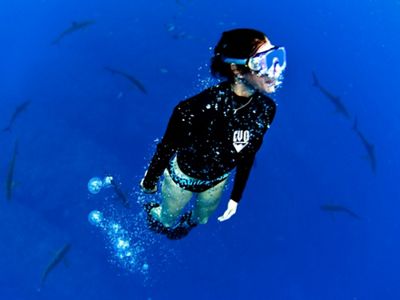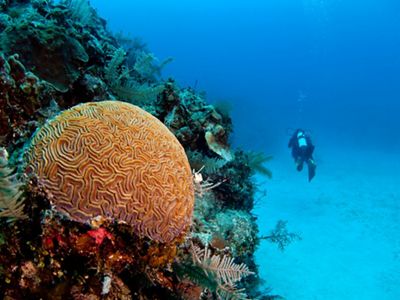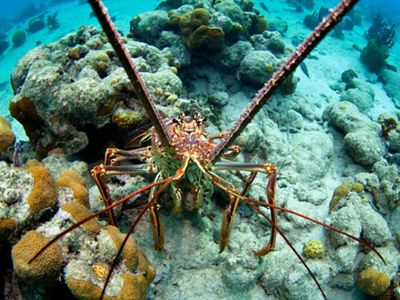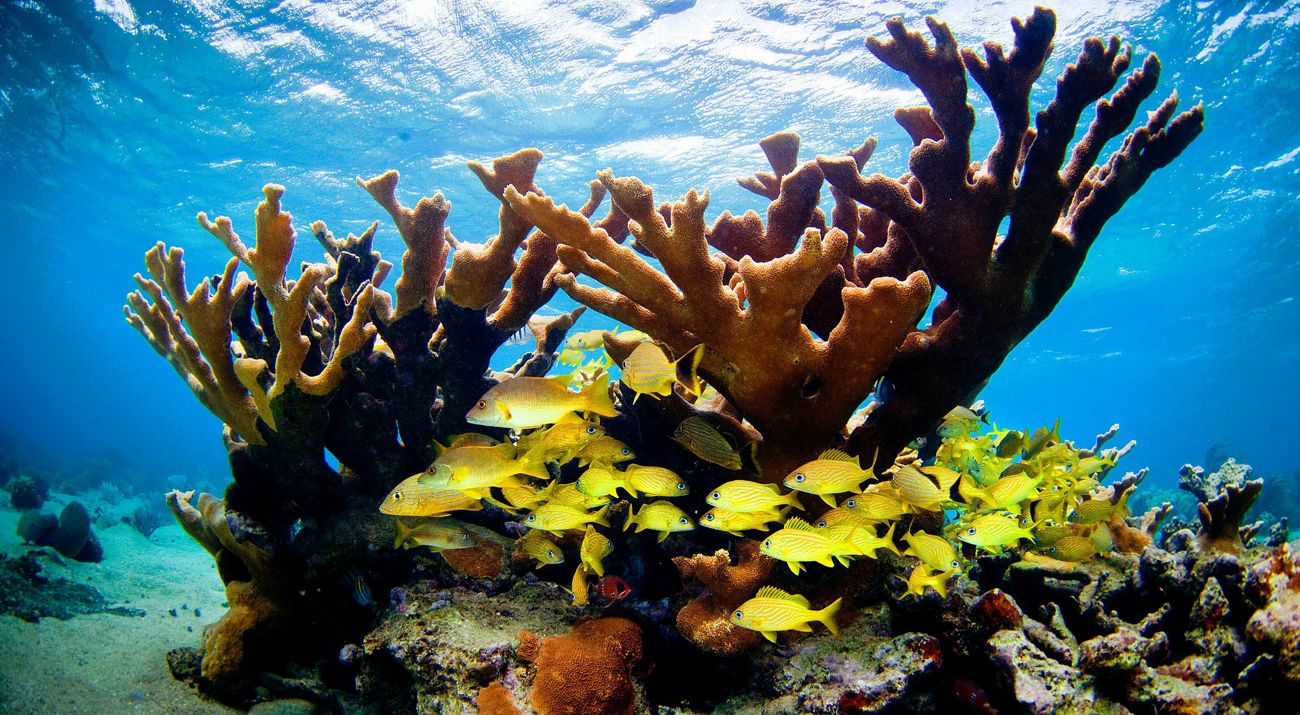The Cuba Connection
Cuba’s flourishing coral reefs help regenerate marine life across the Caribbean.
June/July 2014
The coral reefs at the mouth of Bahía de Cochinos, on Cuba’s southern coast, are just a few dozen yards from the beach, but they still teem with life. Stoplight parrotfish, groupers and porcupinefish flit among neon-hued tube sponges and thriving stands of elkhorn and staghorn coral. In many other places across the Caribbean, the bath-warm water would probably be packed with people, the shore lined with hotels, and the corals and other sea life reeling from pollution and overfishing. At Bahía de Cochinos, however, there are just a few visitors in scuba gear, including Cuban land managers and The Nature Conservancy’s scientists, drifting through a largely untouched wonder world.
The sense of isolation is even more surprising because Bahía de Cochinos, which translates to Bay of Pigs, is world famous. It was here that roughly 1,400 CIA-backed Cuban exiles landed in April 1961 to overthrow the new government of Fidel Castro. A billboard a few miles north on the road to Havana reads Hasta aquí llegaron los mercenarios (“The mercenaries made it this far”), and in the nearby community of El Girón, an old fighter plane sits outside a museum filled with machine guns and other relics from the failed invasion.
The island’s turbulent history is just one of the reasons Cuba has arguably some of the best-preserved coral reefs in the Caribbean. Now history is being made again. Castro has stepped down, and after facing down the United States and its embargoes for more than 50 years, the nation is experiencing a slow but steady wave of reforms that have put Cuba at a political and economic crossroads.
The doors are also swinging open on the island’s natural environment. Not all of Cuba’s reefs are as well-preserved as those at Bahía de Cochinos. Many suffer the effects of overfishing, even some in protected areas. And the island’s position at the junction of multiple Caribbean currents means its waters directly support marine life hundreds of miles away, which is why The Nature Conservancy is helping Cuban scientists and land managers prepare for the future—whatever it may hold.

Pointing like a tongue from the Gulf of Mexico into the Caribbean, Cuba is a biological bridge between the two waters, as well as between southern Florida and the Yucatan. Its location and size—it is bigger than all other Caribbean islands put together—has made it the most ecologically diverse island in the region, especially the waters off its shores. Cuba’s 2,500 miles of coral reefs—nearly a third of all reefs in the Caribbean—are often described as a time-warp window into what much of the Caribbean looked like 50 or 100 years ago, with flourishing populations of sea turtles, manatees, sharks and other large fish inhabiting huge, healthy coral reefs.
Even though Havana is only 230 miles from Miami, the island has been largely cut off from the United States since the 1959 revolution that set up a socialist state run by the Communist Party, which banned most forms of private enterprise. The long-standing embargo—combined with the later collapse of the Soviet Union, the island’s economic patron—checked Cuba’s development.
One silver lining of the economic stagnation, however, was that many of the island’s reefs suffered less of the pollution, habitat destruction and overfishing its Caribbean neighbors saw as their coastal industries grew.
It helps that the Cuban government has taken a highly systematic approach in creating an extensive collection of parks and protected areas, says reef scientist Phil Kramer, director of the Conservancy’s Caribbean Program. “Science is held in high regard in Cuba, and scientific recommendations are often headed by policymakers.” The process is streamlined when everyone works for the government, from lawmakers to scientists to fishermen. (It didn’t hurt that Castro himself was an avid diver, he adds.)
Starting in the early 2000s, the government set aside portions of important, representative ecosystems and created marine reserves specifically to protect spawning areas of snapper and grouper, which have been fished almost to extinction elsewhere. Today, 103 protected areas include nearly 20 percent of the country’s marine shelf and 15 percent of its land area, with another 108 areas proposed.
But Cuba’s ecosystems are still just as vulnerable as its neighbors’ to rising sea levels and coral-bleaching events brought on by climate change. Many of the island’s valuable commercial fish stocks—including lane snapper, mullet and Nassau grouper—have suffered from overfishing, its protected areas are understaffed and underfunded, and resource managers struggle with limited funding and data. In 2008, Fidel Castro stepped aside after 49 years in power, and under his brother Raúl the restrictions on private businesses have slowly started to lift. New hotels and restaurants are opening, and the island’s booming beach-based tourism industry is growing more than 10 percent a year.
Development on Cuba’s shores can ripple outward to other countries, says Kramer. The health of the island’s waters directly affects ecosystems from the southeastern United States to Mexico and beyond, making it a linchpin in the ecology of the greater Caribbean. The island is the second-largest contributor of coral larvae in the region. Larvae of mutton snapper and gray snapper that originate in Cuba ride the Caribbean and Gulf Stream currents and end up as far away as Florida, the Bahamas, Haiti and the Cayman Islands. Embargoes mean nothing to migratory species.
“The way Cuba stewards its marine and terrestrial environments has a direct impact on the biodiversity of the United States,” Kramer says. “We have a strong vested interest in seeing that they do any kind of development with as much science and sound advice as possible.”

That’s how John Knowles, who manages the Conservancy’s digital library of Caribbean conservation data, has ended up in a conference room at the Hotel Occidental Miramar in Havana. He and Jorge Brenner, an associate director of marine science at the Conservancy, are teaching 11 Cuban scientists and land managers the finer points of using geographic information systems (GIS) in conservation decisions.
The participants are mostly young employees of Cuba’s national parks agency and the Centro Nacional de Biodiversidad (National Biodiversity Center), and everyone is soaking up Knowles’ expertise on identifying and managing environmentally sensitive areas with satellite data. When the concepts get too technical for the Cubans’ limited English, Brenner steps in to translate.
Technologies like GIS aren’t as widely adopted in Cuba, so, “we’re providing training that will assist in the mapping of their protected-area system,” Knowles says. “It sounds pretty basic, but this information goes a long way in supporting decisions that are made for their protected areas.”
Cubans are eager and able to take the reins once they have the right tools and training, he adds.
The challenge, according to Conservancy staffers, is overcoming the economic limitations that make it difficult to put theory into practice in Cuba. The average monthly wage is around $20, and marine scientists and park rangers must be creative in getting the tools needed to do their work; they often have to share boats, or occasionally rent them from tour operators. Access to free online satellite data is hampered by bandwidth limitations, and Cubans can’t buy data or programs from U.S. vendors. But they are used to making do with limited resources.
“The most difficult thing for us in Cuba is the equipment, the funds—not the human resources,” says Maritza García, head of Cuba’s national park service. Cuba has a highly regarded public education system and spends more than twice as much of its gross domestic product on education as the United States does (12.8 percent versus 5.4 percent in 2010). As a result, Cubans generally bring a high level of education to their work; it’s not uncommon to meet fishermen with advanced degrees. In terms of conservation, Kramer says, the more people understand how the oceans work, the more open they are to participating in coastal zone planning.
These workshops, then, help Cubans use what they do have most efficiently. Beatriz Martínez-Daranas, a professor at the University of Havana’s Center of Marine Studies who researches sea grasses, says the GIS course is valuable to her because it brings biologists and geographers together. “Usually biologists don’t have a good idea about what GIS means, and how it can help us make decisions,” she says. The skills help visualize living systems as a whole, but they’re also useful when she needs to explain her findings to decision-makers. “Now we can begin to talk in the same language.”
Says Knowles, “They really want to get down and dirty and practice this stuff over and over.” Workshop attendees stay up until 2 a.m. developing a spatial data set of the entire country, powered by enthusiasm and strong Cuban coffee.

The Conservancy has worked with Cuban scientists since technical exchanges began in the 1990s. A chilly political climate slowed things down over the following decade, but a formal collaboration with Cuba’s National Center for Protected Areas began in 2007. Cuban and U.S. laws limit the Conservancy’s role to advising, training and technical assistance; there are no Conservancy offices or employees in the country, and all travel is arranged under a special license from the U.S. Treasury Department.
Despite those hurdles, the Conservancy has collaborated with institutions and professionals in Cuba and throughout the region to improve science and conservation. It is also helping to set up a conservation plan involving Cuba, Haiti and the Dominican Republic—the latter two nations share the island of Hispañola to the east—since the two islands’ marine environments are so intertwined.
The shared goal of protecting coral reefs led to a two-week joint survey expedition to the Jardines de la Reina National Park off southeastern Cuba in April 2012. Named the “Gardens of the Queen” by Christopher Columbus, the area is one of the most outstanding untouched reef ecosystems left in the Caribbean, says Kramer, who led the expedition as a joint effort with the Environmental Defense Fund, which was funded by the Waitt Foundation. The team’s boat was allowed to visit the site, but they were limited to collecting observational data because they couldn’t get a permit to take samples. And because of the country’s controls on emigration, the local marine scientists were allowed to board the foreign vessel only as guests during meals. Even though it was a fairly basic expedition, Kramer still considers it a success—the first time a U.S. research ship was granted permission to enter Cuban waters in nearly a decade.
“It is frustrating sometimes,” Kramer says, noting the patience required to work here. “Cuba is a tremendous bureaucracy.” Nonetheless, he adds, “the Cubans have made it clear they support international conservation collaborations, but as equal partners—and they have considerable scientific expertise to offer. We need to recognize that they have managed to accomplish conservation results that even we in the United States could learn from.” The Cuban government has progressive, science-based management practices for the coastal waters, he says.
On the final afternoon of the four-day GIS course last October, everyone in the room looks tired but satisfied, like a family after Thanksgiving. “This won’t be the last course with international cooperation,” promises García. “The collaboration is getting better every year.”
Working with the Conservancy has been fantastic, says Pedro Alcolado, a researcher at Cuba’s Institute of Oceanology. “[The Conservancy] has been a catalyzer ... [and its] participation with national protected areas has been very, very effective.” The work has been critical to expanding the boundaries of the Cienega de Zapata park and securing funds from sources such as the United Nations Development Programme, he says.
Even though the Conservancy doesn’t have full-time staff coordinating work in Cuba, it is involved in many marine and terrestrial projects here. Few institutions or nongovernmental organizations operate in the country on the same scale, says Marianne Kleiberg, the Conservancy’s director of conservation in the Caribbean. Hiring a Cuba program coordinator is on her to-do list, as is helping the country set up its first coral nurseries.
The most pressing conservation topic, however, is the rising tide of visitors. Even though it has one of the fastestgrowing tourism industries in the region, Cuba still has a chance to preserve the biological riches that are a result of its isolation, Kleiberg says. The potential end of the embargo could be a huge boost to the island’s economy but a disaster for its reefs—and those of the rest of the region as well.
That’s why the Conservancy is offering as much advice and assistance as the law allows, and would like to see the country invest tourism revenues in its reefs in a sustainable way. Meanwhile, says Brenner, Cubans are also teaching foreign scientists how conservation goals for protected areas can be implemented. Ultimately, marine research and conservation may help open doors that foreign policy had closed, until people can flow to and from the island as freely as fish.
